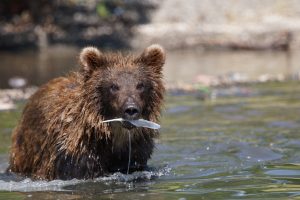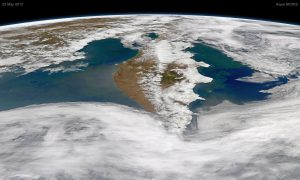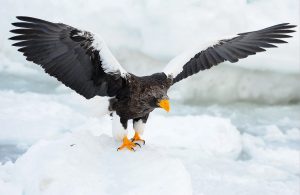96 Russian Domain: Physical Geography – Kamchatka
The Oxford dictionary defines a peninsula as “a piece of land almost surrounded by water or projecting out into a body of water.” Kamchatka is a Russian peninsula with volcanoes.
The Kamchatka Peninsula extends 900 miles southward from the nearly easternmost part of Russia. With over 350,000 people in an area over 182 thousand square miles, Kamchatka averages about two people per square mile. In truth, over half (187 thousand) of those people are in its provincial capital city Petropavlosk-Kamchatsky.
Fire and Ice. While Russia is well known for its cold weather, Russia’s Kamchatka Peninsula, along with the adjacent Kuril Islands, provides the country with a unique combination of fire and ice. As part of the Pacific Ocean’s “Ring of Fire,” Kamchatka contains volcanoes, both ancient (dating to the Pleistocene Era) and active (30). At the same time Kamchatka’s high latitude and often high elevation bring snowfall and cold to the region. Preservation of region has been promoted by establishment of nature preserves, combined as a UNESCO World Heritage Site. Due to its remote location, the peninsula had relatively late exploration and remains notably little affected by human interaction.

Photo by Kuhnmi on Flickr.
The Kamchatka Peninsula is in the Russian Far East and extends into the Pacific Ocean, separating the Sea of Okhotsk from the Bering Sea portion of the ocean. The Kuril Islands dip southward from the tip of Kamchatka. Astride the edges of tectonic plates, Kamchatka benefits from the geological forces of subduction that release molten material from the Earth’s mantle. The resulting rise of this magma creates not only volcanoes and eruptions, but also a variety of thermal activity in Kamchatka, including hot springs and geysers. Eurasia’s largest active volcano is Kamchatka’s Mount Kluchevskoi, while Mount Karymsky has been erupting continuously since 1996.
Only four locations planetwide have geysers that shoot sprays of water and steam from the ground, typically on a predictable schedule. Along with the geysers of Yellowstone National Park in the United States and similar sites in Iceland and New Zealand, Kamchatka’s “Valley of Geysers” contained twenty large geysers and some 200 smaller thermal springs. However, on June 3, 2007, the structural collapse of an adjacent mountainside delivered an immense tonnage of rock material into the Valley of Geysers covering geysers and damming water flow from the Geyser River. For excellent coverage (explanation and photography) of the event go to:
http://www.kscnet.ru/ivs/expeditions/2007/Geyser_Valley-06-2007/Geyser_Valley-06.htm
The largest of the geysers, Velikan Geyser, was not buried and is active. Will the rest of the valley eventually restore itself or will a new physical regime be established? Undoubtedly the post-Soviet flow of scientists and sightseers will continue to arrive to view the valley and other remarkable pieces of Kamchatka. For a spectacular 360° view, go to https://www.airpano.com/360photo/Kamchatka-Geyser-Valley/

While tourists love viewing the remarkable geologic sites, travelers also enjoy watching the diverse wildlife in Kamchatka. Opportunities to view the Kamchatka brown bear excite tourists. The concentration, or population density, of brown bears there is among the highest anywhere in the world. The heavy concentration (millions!) of salmon in the region’s streams provides the bears’ main source of food. Other noteworthy mammals in Kamchatka include elk, fox, and sable, as well as marine mammals such as walrus, seal, and sea lion. Among birds of note is Steller’s sea eagle, unique to Kamchatka.

While the geologic processes that created Kamchatka are ancient, human activity on the peninsula has been relatively recent. Although native populations of Itelman and Koryak already existed on the peninsula, Russian discovery of Kamchatka came only in the late 17th century, with subsequent Cossack settlements being founded in 1704 and 1706. Russian explorer Vitus Bering founded the city Petropavlovsk-Kamchatsky in 1740. Itelman and Koryak populations were diminished through struggles with Russians, but most significantly by smallpox.

Russian discovery of Kamchatka’s varied thermal phenomena came only in 1941. Prior to that, the volcanoes were a bold feature of the landscape, but geysers and hot springs were not so evident. Scientific evaluation and charting of these thermal sites began in the 1970s.
Kamchatka’s economy has long been focused on fishing, with pollack, salmon, and crab being the most important catches. The lumber industry has played a secondary role, mainly exporting raw timber to Japan and Korea. Of late and certainly only since the removal of “closed” status for Kamchatka, ecotourism has become an important contributor to the regional economy.
Kamchatka. Video by Vimeo-Free-Videos from Pixabay
Direct Link to Video (New Tab)
Because of its strategic location, Kamchatka was a highly secret and tightly secured region, even closed to Soviet citizens. While Kamchatka remains the base for the Russian Pacific submarine fleet, the region now is open to Russian and foreign travelers. Due to difficult times in the Russian economy, military spending has decreased in Kamchatka as compared to Soviet times.
Did You Know?

For remarkable surfing experiences, head to Kamchatka. Access began with the breakup of the Soviet Union, but few surfers have set foot on the black sands, ridden the cold waves, and viewed the volcanoes from Kamchatka.
Georg Wilhelm Steller accompanied Vitus Bering on an expedition to the region, a voyage ordered by Tsar Peter the Great. Steller studied fauna and flora in the region, getting his name attached to the eagle.
Kamchatka is featured in one of the episodes of “Wild Russia,” the popular TV show on the National Geographic Channel.
Check Your Understanding
Cited and additional bibliography:
Bello, Kathia. TheTravel. “Surfing Capital Of Russia? Kamchatka Seemingly Has It All,” December 3, 2021. https://www.thetravel.com/surfing-in-russia-kamchatka/.
Deischinger, Harold. n.d. Brown Bear at Kurilskoye Lake in Kamchatka. Accessed May 27, 2020. https://tinyurl.com/KamchatkaBrownBear. Attribution 2.0 Generic (CC BY 2.0).
Dooley, Kevin. 2017. Petropavlovsk, Kamchatka, Russia. https://tinyurl.com/petrokam. Attribution 2.0 Generic (CC BY 2.0).
Kuhnmi. n.d. Avachinsky Bay in Front of the Volcano Vilyuchinsky. Accessed May 27, 2020. https://tinyurl.com/vvolc. Attribution 2.0 Generic (CC BY 2.0).
Logan, Andrew. n.d. “Kamchatka: The Ring of Fire.” Www.Kamchatkapeninsula.Com. Accessed May 27, 2020. http://www.kamchatkapeninsula.com/ringoffire.html.
tdc, Robert. n.d. Steller’s Sea Eagle. Accessed May 27, 2020. https://tinyurl.com/StellersSeaEagle. Attribution-ShareAlike 2.0 Generic (CC BY-SA 2.0).
Vimeo-Free-Videos. 2015. “Kamchatka.” Pixabay. https://pixabay.com/videos/kamchatka-russia-outdoor-nature-1435/.



